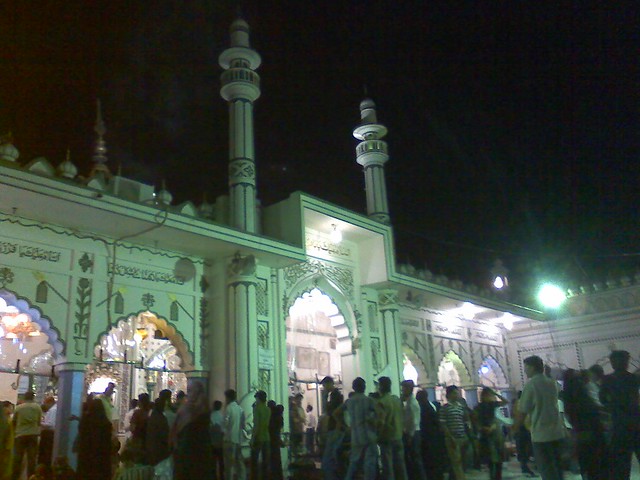History of Dargah Hazrat Abbas-Lucknow
Dargah (shrine) Hazrat Abbas is the
oldest and most popular among the shrines built in Lucknow in memory of martyrs
of Karbala. Like most of other holy shrines in Lucknow, this Dargah was not
built by any ruler or his noblemen. Rather, a non- affluent devotee of Imam Husain,
one Mirza Faqir Beg founded it. Dedicated
to Hazrat Abbas, who is revered by Muslims for his loyalty to Imam Husain and
his matchless efforts to fetch water for children at the battle of Karbala, the
history of dargah dates back to the period of Nawab Asaf-Ud-Daula who ruled Awadh
from 1775 to 1797.During his regime Mirza returned
to Lucknow with a holy relic from Karbala.
About
the relic, he said that Hazrat Abbas, Imam Husain’s brother and ‘Alamdar’(commander)
of his small force at Karbala in a dream had helped him unearth the rectal
crest that had surmounted his ‘Alam’( Standard) of ‘Abbas on 10th of
Muharram at the battle of Karbala in Iraq in 680 A.D. He placed the crest at
his home in Rustam Nagar. Soon the news about the crest spread and people began
visiting his place with offerings and prayers for the fulfillment of their
wishes, for Abbas is known as Babul- Murad (Gateway to fulfillment of wishes).
(Impressive Entrance of Dargah Hazrat Abbas- Rustam Nagar
,Lucknow with signs of Awadh style of architecture developed during Nawabi era)
The building at first consisted of four bare
walls, an unadorned roof, and a small courtyard. The growing popularity of the
relic earned the attention of Asaf- Ud-Daula..He
visited
the place and ordered that a dome be erected over the place to convert it into
a Dargah .The place became popular among those
in search of healing, sons, and
spiritual blessings, and flower and sweets merchants began doing a booming
trade in front of the gate. A turning point came when Nawab Sadat ‘Ali Khan
fell seriously ill about 1801.He vowed to construct a magnificent new building for
the shrine should he recover. Nawab got rid of his ailment in 1803.He visited
shrine with his courtiers after taking out magnificent procession.He distributed
money all along the way to the thronging multitudes lining the streets. At Dargah,
he offered prayer of thanksgiving. Then, he ordered for the construction of a
new edifice with an impressive gilded dome. He established a fund to cover the
shrine's expenses, and people began gathering there regularly on Thursday evenings. He also built
two separate enclosures for male and female visitors to the shrine.


His successor and son, Ghazi-ud-din
Haider, who was crowned as the first King of Awadh in October 1819 by British,
provided a Naubat Khana at the entrance of Dargah in the form of a double storied
gateway. Naqqara (large drums) were sounded from the upper storey to inform the hour of the day as well as announce
the arrival guests of the royal
household on their visit to the shrine. The King also provided the inner
sanctum where the iconic alam was preserved with silver foiled doors.
Naseer-ud-Deen Haider succeeded Ghazi –Ud-deen
Haider as the second King of Awadh (1827-1837).His favorite queen Malika Zamani
started a permanent kitchen for free distribution of food to the poor. She used
to visit Dargah on every nauchandi jumeraat (first Thursday of each month) with
an offering of ten thousand rupees. Down trodden waited eagerly for her
procession consisting of a hundred elephants with silver howdah (mounted seat)
and gold embellishments. It had a number of palanquins and oxen driven
carriages for the accompanying ladies. The queen sat in a large ‘sukhpal’
(decorated carriage) covered with a brocade silk canopy while her companions distributed
alms to the destitute with generosity.
The Dargah also played as host to the
soldiers of Begum Hazrat Mahal during the first war of Indian Independence. In
1858, it served as headquarters of the anti-British forces..Shah Ahmad Ullah, perhaps
the most influential leader of the freedom struggle and one of the chief
commanders of Begum camped at Dargah before leaving for Bareilly where he was
captured and executed. After recapturing Lucknow, the British soldiers
plundered Nawabi buildings and they did not spare even Dargah. They removed
gold in alam and the dome. The British auctioned
priceless jewels and decorative preserve d at Dargah along with the valuables
of King Wajid Ali Shah.
The
shrine even today is manifestation of popular love for the family of the
Prophet and belief in the efficacy of supplicating its members. Devotees throng
at Dargah in large number to invoke blessings of Hazrat Abbas to overcome their
problems.

No comments:
Post a Comment